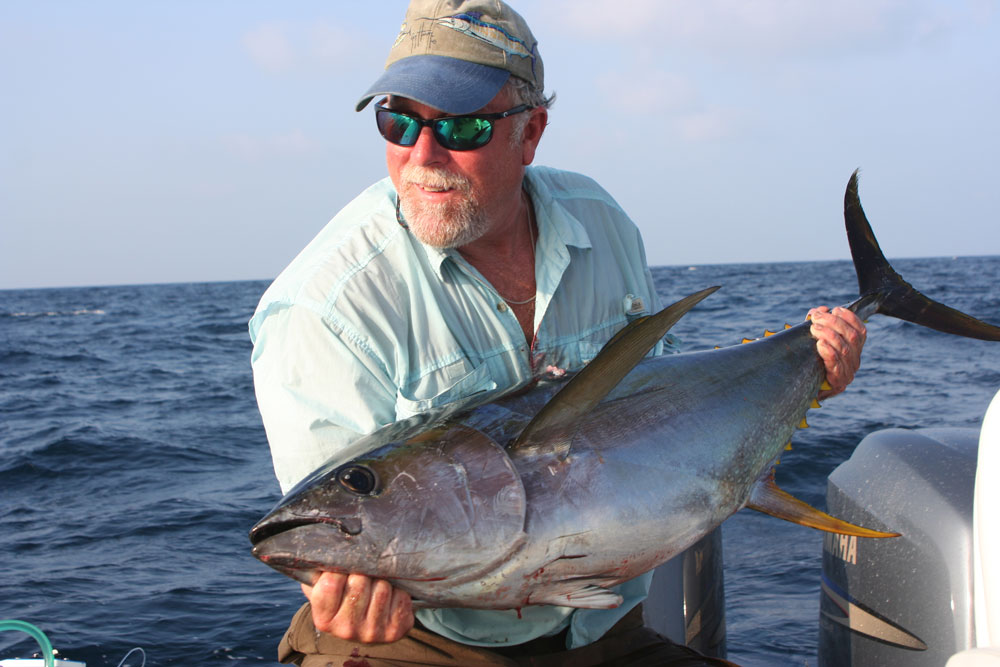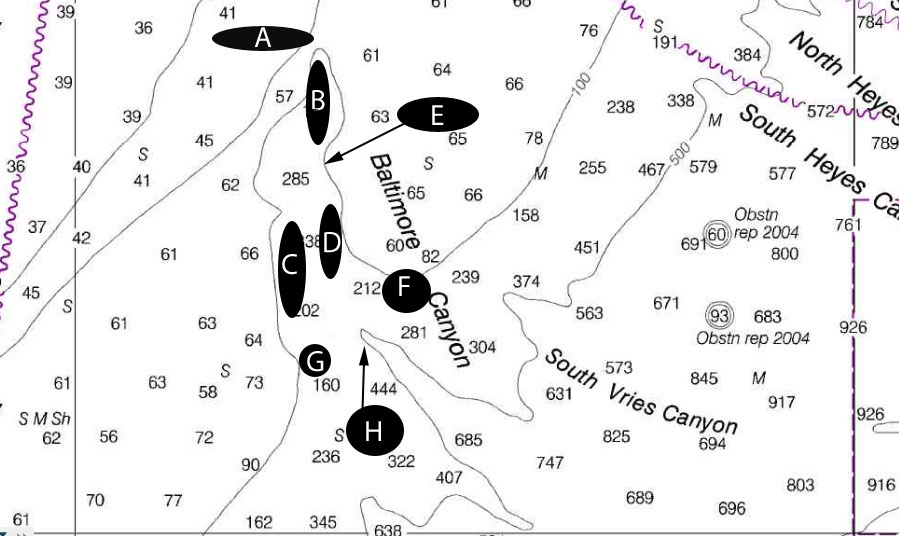You want an offshore fishing adventure peppered with multiple pelagic species, high-octane drag-screaming action, and endless blue water? Then it’s time to cruise for the edge of the Continental Shelf and fish Baltimore Canyon.

Baltimore Canyon is one of the most dramatic forms of offshore structure anywhere in the ocean off the DelMarVa coastline—and it makes for some awesome offshore angling adventures. Here you’ll encounter white and blue marlin, mahi-mahi, wahoo, and tunas including yellowfin, albacore, and big eye. If, that is, you know how to fish at the Baltimore. Read on, then match these spots up with the chart at the end.
Baltimore Canyon Offshore Fishing Hotspots
Zone A - About 60 nautical miles from the Ocean City inlet to the tip, and around 62 nautical miles from Indian River inlet, Baltimore has several stand-out features. The first you’ll want to check out is just inside of the tip of the canyon, marked as hotspot A on this chart. This area isn’t really part of the canyon itself, but this is an area where currents are constantly mixing and changing. You may find weedlines here, you may spot common dolphin (known as “two-tones,” these are the dolphin that yellowfin tuna often feed near), or you may spot rips. In all of these cases, it’s well worth pulling back on the throttles and stating the day here.
BONUS TIP: Late in the season make sure you have a Green Machine or two in the spread, because albacore frequent this area as well. But savvy anglers don’t buy their Green Machines pre-rigged. Instead, they get them un-rigged, and set them up with 100- or 120-pound test instead of the heavier stuff pre-rigs are made with. You’ll notice the action of the lure increases greatly with the lighter leader, and the albacore love it.
Zone B - The tip of the canyon allows you to try trolling through constantly rising and falling depths, as you go from one side to the other. The drop-off is usually well-marked by lobster pot balls along the edges, and if you’re a fan of mahi-mahi, this is the most reliable place around to find them.
Zones C and D - Here, you’ll find the sharpest drop-offs of the canyon, known as the south wall (C) and the north wall (D). Most anglers will zig-zag along one wall or the other, covering waters from 70 fathoms or so to 100 or 150 fathoms. Trolling the walls is a classic technique, and it works.
Zone E - Take particular note of the bulge in the north wall, marked by hotspot E. Yes, it can be quite productive during the day, but night fishermen planning to overnight at the Baltimore in search of tuna fish really need to remember this spot. For whatever reason, it produces well when a light north-east breeze pushes you slowly from 70 to 100 fathoms. Yellowfin are the norm, but bigeye will pop up here, too. Don’t forget your green night-light—it’s key for bringing up bait and fish from the depths. And if you’re not flocked by squid after an hour or so of drifting in the dark, move on. When the squid aren’t around, neither are the predators.
Zones F and G - The northern and southern bights of the canyon, are naturally places anglers will want to probe. Mixing currents often cause weeds and flotsam to collect here—as well as the fish. White marlin, blue marlin, and yellowfin all make showings at the bights, and bigeye hunters will find their quarry here, too (especially F), though your best bet when in pursuit of that species is to keep a sharp eye out for pilot whales, and fish amongst them.
Zone H - Outside the bights and outside of the canyon itself lies the 500 fathom tip. It’s deep here—really deep. Much of the time the tunas will be more plentiful in other areas of Baltimore, but anglers ISO swordfish will certainly want to keep the 500 fathom tip in mind. Try dropping squid baits to 50’, 100’, 200’, and 300’ at night, on lines illuminated with glow sticks rigged 20’ above 12/0 circle hooks.

As in all fishing, finding and focusing on structure is a key to success. And here in Baltimore Canyon, you’ll find plenty of it. All of the pelagic predators frequent these big-city waters—so anglers hunting for them should make their way here, too.
Sign up here to get the weekly FishTalk Chesapeake Bay and Mid-Atlantic fishing reports in your email inbox, every Friday by noon.